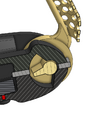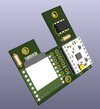If I can get all of this stuff to work out like I think it will, I will absolutely produce a kit. I am in the process of prototyping, designing, and testing for the purpose of making finished communicators available for sale. The biggest factor that will influence the price is the amount of time I need to spend on each one, and I am not at all opposed to make it less expensive by not spending time on finishing/assembly and bundling up and shipping out the raw 3d-printed pieces, circuit boards, microcontroller, magnet, switches, SD card, speaker, battery, all of it. There would be painting and wiring involved, but a kit could be significantly less expensive than a fully-assembled communicator.
Also of note, everything will be serviceable. The whole thing will come apart by simply removing a couple of screws, and the ATtiny85 microcontroller will be mounted in a socket so that it can be pulled and reprogrammed. Also, the SD card can be removed and loaded with different audio files if desired.
I will also be making a downloadable kit with a parts list and instructions for those who have a 3d printer, and the microcontroller software will be freely available in case hacker types would like to play with it.






